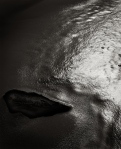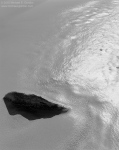There is no such thing as “good” or “bad” photographic light. There is just light.
Brooks Jensen, LensWork.
Just last week, while photographer Floris van Bruegel and I walked towards Death Valley National Park’s Ibex Dunes, Floris commented that I used direct light in my photographs more than most photographers. I harbor no shame about this, and believe that I’m at an advantage in being able to visualize photographs in whatever available light is before me. While many nature and landscape photographers would have you believe that we are limited to the Golden Hours or to the twilight found at each end of the day, there simply exists light that best benefits your subject or light that is less than ideal for your subject. If you’ll contend that the light is “bad”, I’ll counter that you’re just looking in the wrong direction.
 The photograph at left, Voyager, was made in the extreme southern end of Death Valley (the Valley proper, that is) last Wednesday. The time was 9:30am. I was up at 5:30am that morning. I had already covered a fair bit of ground, and had even cooked and eaten breakfast by the time I found this scene. I would estimate that 99 of 100 photographers would have told me that this was horrible light and no photographs could be made. Were it not for my experience and ability to visualize a scene in the final print (there is no such thing as PREvisualization!), I might have concurred. Fact is, were it not 9:30am and had the sun not been beating harshly on this wet mud, I doubt that I would have ever been able to see this. Before you rule out “bad” light, rule out your preconceptions and make the exposure. For digital photographers, this costs nothing. For film photographers, it costs only a modest amount to expand your seeing and possibilities. What could you possibly have to lose?
The photograph at left, Voyager, was made in the extreme southern end of Death Valley (the Valley proper, that is) last Wednesday. The time was 9:30am. I was up at 5:30am that morning. I had already covered a fair bit of ground, and had even cooked and eaten breakfast by the time I found this scene. I would estimate that 99 of 100 photographers would have told me that this was horrible light and no photographs could be made. Were it not for my experience and ability to visualize a scene in the final print (there is no such thing as PREvisualization!), I might have concurred. Fact is, were it not 9:30am and had the sun not been beating harshly on this wet mud, I doubt that I would have ever been able to see this. Before you rule out “bad” light, rule out your preconceptions and make the exposure. For digital photographers, this costs nothing. For film photographers, it costs only a modest amount to expand your seeing and possibilities. What could you possibly have to lose?
You are visiting the blog of fine art photographer Michael E. Gordon. For additional photos and information, please visit his official website.














I would argue that there is such a thing as pre-visualization. I like to call it a consciously manipulated creative hallucination before the fact. But that’s a whole separate post….
🙂
Excellent post Michael. The example image works perfectly to make your point. While true for many if not all locations… it is especially true in Death Valley to take the time to observe lighting at all times of the day for opportunities. Landscapes transforms greatly under different lighting conditions creating an infinite number of photo opportunities. It pays to be open minded when it comes to lighting.
Excellent point about visualization, a much better and more accurate term than pre-visualization (which in most cases – landscape and nature photography in particular – ends up in disappointment and a reduced capacity for visualization when expectations are not met).
I was with Floris once at Anza Borrego and he was a little more hurried than I was in leaving a canyon half in shadow. I can visualize the final print but sometimes just can’t make the connection in processing. Black and white is a little more forgiving compared to the way color loses something in the later hours. You can always pick up some kind of side lighting which helps most of the time. It’s nice to be so enthused about photography to find yourself even skipping breakfast and wondering where all the time went come lunch time.
THANKS for the comments, all!
Hey Steve: While on photo trips, I have only two priorities when I get out of bed: make coffee and get moving! I stop to cook breakfast once I’ve used up the best of the light and feel [temporaraily] done with photographing. This time usually usually arrives between 9 and 10am. As long as I have coffee, I am golden! 🙂
What’s coffee? Light weights LOL
Great post Michael – that image looks like sensual naked oily skin 😀 Just to be clear, I meant nothing but compliments when I noted your more than usual use of ‘skanklight’ 😉 It’s something I admire.
I typically find some aspect of direct light to really bring images to life (like this one), as opposed to the deluge of low contrast light that we see. Finding opportunities to use that kind of light, without creating an exposure nightmare, is the really tough part.
What I especially like about this is the abstraction of the subject through scale and framing. When I see a photo like this I at first try to understand what the scene is but then if it’s not clear, I relax and simply enjoy the texture, color, pattern etc of the composition, sometimes imagining a world of a different scale than the actual subject. The light and reflection in this really boosts that effect.
Thanks for the comments, Floris and Charles!
Michael,
Relly nice photo, and I agree there is no bad light, just poor ability to see.
THANKS for your comment, Youssef!
When I come home from a trip and have no important photographs to show from it, I never blame the subject matter, the light, or the weather. I blame only my inability to see.